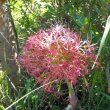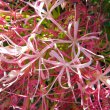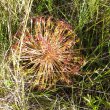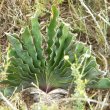Boophone disticha
| Botanical Name | Boophone disticha |
|||||||||||
| Family | Amaryllidaceae - The amaryllis family. |
|||||||||||
| Pronunciation | bo-OFF-on-ee DIS-tik-uh |
|||||||||||
| Common Name(s) |
English: Bushman Poison Bulb; Century Plant; Sore-eye Flower
Afrikaans: Boesmangifbol; Perdespook; Seeroogblom
IsiXhosa: Incwadi; Incotho
IsiZulu: Incwadi; Incotho ; Ibhade
Sesotho: Kxutsana-ya-naha; Leshoma
Setswana: Leshoma
IsiNdebele: Incoto
siSwati: Incumbe
|
|||||||||||
| Plant Group |
|
|||||||||||
| Plant Size |
|
|||||||||||
| Position |
|
|||||||||||
| General Information |
|
|||||||||||
| Specific Information | Boophone disticha is a very large, very poisonous bulb up to 17 cm in diameter, covered in darkly coloured thick dry scales. Much of the bulb protrudes from the ground. The grey-green wavy edged leaves are prominently arranged in a fan and usually appear after flowering. They can grow up to 60 cm in length. The large, round flower heads, each with its own stalk, are held together on a very short, thick stem. The stalks grow a longer after flowering and the whole head, containing the fleshy seeds, breaks off at the top of the dried main stem to go tumbling across the veld in the wind, distributing the seeds as it goes. An extensive root system develops beneath the bulb. These bulbs will grow in the veld for well over a hundred years. The bulb of Boophone disticha is very toxic and if ingested may cause death. |
|||||||||||
| Ad Break | ||||||||||||
| Flowers | ||||||||||||
| Description | funnel-shaped, opening out with 5 long lobes with anthers held exposed above the flower on stalks attached to the central stem |
|||||||||||
| Season |
|
|||||||||||
| Colour |
|
|||||||||||
| Growth Rate |
|
|||||||||||
| Plant Uses |
|
|||||||||||
| Distribution and Habitat | in the Northern Cape, Eastern Cape, KwaZulu-Natal, Free State, Gauteng, Limpopo, Mpumalanga, and North West, and north up to Uganda, in Albany Thicket, Fynbos, Grassland, Indian Ocean Coastal Belt, Nama Karoo, Savanna and Succulent Karoo habitats, in dry grassland and rocky areas |
|||||||||||
| Planting Suggestions | Plant in very well-drained sandy or rocky soil in a position where is is protected from heavy frost. Ensure that the neck and part of the bulb are exposed above the ground. For container planting use a deep container (about 50 cm) and add a little bone meal to the soil mix. Grown from seed it will take 7 - 9 years to flower. Water when the leaves start to show and sparingly through summer. As soon as the leaves begin to yellow, withhold watering until the following season. Watch out for amaryllis caterpillar (Diaphone eumela) on the developing flowerhead. |
|||||||||||
| Medicinal Uses | In earlier times the thick liquid that exudes from the bulb was used as an arrow poison for smaller game. Preparations are still used in initiation rites of young males and diviners. Despite its known toxicity and the many documented deaths from its use, Boophone disticha is commonly available at 'muthi' markets and is used for a number medicinal applications: to treat headache, chest pain, abdominal pain, insomnia, painful joints, swelling, bruises and wounds, boils and abscesses, to stop bleeding of wounds, for rashes, burns, septic wounds and as a sedative. If exposed to the open flowers in a confined space, the eyes may become sore and a headache may accompany this, hence the common name 'sore-eye flower'. The plants are known to be poisonous to cattle and sheep. The bulb of Boophone disticha is very toxic and if ingested may cause death. |
|||||||||||
| Ad Break | ||||||||||||









Comments
I fell in love with beautiful Boophone disticha
Hi there, does anybody know where I can get some bulbs/plants of Boophone disticha and get them send to the Netherlands?
Greetings, Willem
Export bulb supplier
Hi Willem
Click on the link for Shire Wild Bulb Nurasery on this page, or go to http://shire.co.za and contact Rob. He exports South African bulbs and has Boophane disticha on his list.
Kind regards
Lorraine
Boophone disticha
I bought a young plant at a succulent show a month ago. I've started to see black spots about 1/8 in. in diameter on the leaves. These spots can be flicked off with my nail with no damage to the underlying leaf. Using a magnifying glass I can't tell if the spot is an insect or not. Any ideas?
Thank you,
Elizabeth
Boophane disticha - scale insects?
Hi Elizabeth
At a guess this sounds like Scale but I don't recall seeing or hearing of it on leaves of bulbs before. It is an insect and in large numbers can be destructive as it is a sap sucking creature and can multiply quite rapidly in suitable conditions. To see if this is scale, Google: 'scale on plants' and look at the images - there are many types but some are very dark brown to black. If you feel that this is scale, go to: http://www.wikihow.com/Control-Scale-Insects-on-Outdoor-Plants. This article will give you all the information you need for organic and non-organic control.
If I am on the wrong track, please send a close-up photo of the spots so I can attempt a further diagnosis. I would be interested to find out if this is scale, as it seems most unusual. It's quite possible that the plant was infected when you bought it.
Kind regards
Lorraine
optimum growth conditions for boophone disticha
what are the most favourable growth conditions for boophone disticha (l.f) amaryllidacaea
Please read through the
Please read through the supplied information. If this is insufficient, I suggest you Google for more information.
Discuss this plant
Share knowledge, ask a question or give an experience.